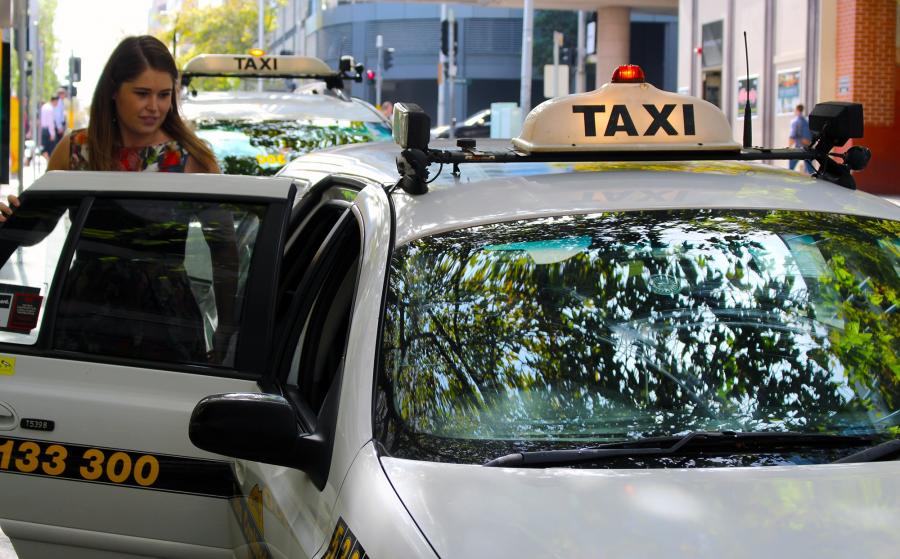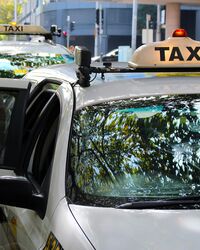Becoming a taxi licence holder
Under new laws, taxi licences can no longer be sold, transferred or leased, and the person or company who operates a taxi (known as the taxi licence holder) will need to have a taxi licence in their name. The holder of a taxi licence can register and operate a taxi.
Taxi licences are now available on application to any eligible person who intends to operate a taxi and meets the standards set out by point to point transport law.
This fact sheet will help taxi licence holders understand their safety and administrative obligations under point to point transport law which they must comply with.
For more information refer to the Becoming a Taxi Licence Holder webpage.
Who is a taxi licence holder?
A taxi licence holder
• uses a taxi licence to operate a taxi service
• has an affiliation with an authorised taxi service provider (belongs to a network) or is an authorised taxi service provider in their own right
How do I become a taxi licence holder?
Licences to operate a taxi service are available through the Point to Point Transport Commissioner’s Industry Portal for an annual fee of $200.
The guide will assist you through the application process or view our demonstration video.
How do I become a wheelchair accessible taxi (WAT) licence holder?
Licences to operate a WAT service are available through the Point to Point Transport Commissioner’s Industry Portal and the application process is the same as for a taxi service. There is, however, no application or annual renewal fee for WAT licences.
Once in the Industry Portal, log into the ‘Taxi Licence Gateway’ and, when you reach the ‘Application Type’ screen, make sure to select ‘Wheelchair Accessible Taxi Licence’.
How much does a taxi licence cost?
An application fee of $200 applies for all taxi licences (other than a wheelchair accessible taxi licence which remains free of charge).
• Taxi licences will be renewable annually at a cost of $200
• There is no application or annual renewable fee for wheelchair accessible taxi licences.
Note: Taxi licences cannot be sold, traded or leased.
Do I need to be an authorised taxi service provider?
To become a taxi licence holder, you must be either an authorised service provider or affiliated to a taxi service provider (in a network). When applying for a licence, you must indicate if you are an authorised service provider or in a network for your application to proceed.
For more information on being an authorised service provider or an affiliated provider, please refer to the following resources:
• Becoming an authorised service provider
Do any geographical operating area restrictions apply to taxi licences?
No. Historical geographical operating area restrictions no longer apply, and all taxis registered in NSW will be able to provide taxi services anywhere in NSW. However, there are additional requirements when providing taxi services in urban areas such as a duress alarm system and vehicle tracking device.
For more information, refer to the Taxi operating areas Fact sheet.
Becoming a taxi licence holder checklist
This checklist will help you to make sure you have done everything you need to do before applying for a taxi licence and before providing taxi services.
What do I need to do before I can start providing passenger services in a taxi for the first time?
- Apply for, and be granted, a taxi licence (go to the Industry Portal to begin your application).
- Become an authorised service provider yourself, or become affiliated with an authorised service provider (in a network).
- Complete the Commissioner’s online short course on ‘Becoming a Taxi Licence Holder’.
- Arrange for the use of a suitable vehicle that is registered with Service NSW as a taxi.
- Make sure the vehicle is painted and fitted with compliant signs, lights and markings.
- Make sure the vehicle is fitted with a compliant fare calculation device ('meter') and security camera system.
- Make sure the vehicle is fitted with a compliant duress alarm system and vehicle tracking device if operating in the Sydney, Newcastle, Wollongong or Central Coast areas.
- Make sure the vehicle’s registration number, contact information for the taxi’s authorised service provider, a listing of all relevant fares and charges and advice of security camera surveillance are on clear display inside the taxi.
- Make sure the vehicle has third-party property insurance cover of at least $5 million.
What responsibilities do I have as a taxi licence holder?
| Abide by safety standards |
The Point Transport (Taxis and Hire Vehicles) Regulation 2017 sets out the safety obligations of a taxi licence holder. There are two levels of obligation, or responsibility: • for some safety standards, the taxi licence holder is identified as a ‘specified person’, in which case they must not violate the safety standard • for other safety standards, the taxi licence holder is identified as a ‘responsible person’, in which case they must ensure, so far as is reasonably practicable, that the safety standard is complied with. For each of the safety obligations below, the level of responsibility has been shown. For more information, please refer to the Safety standards for taxis webpage. |
| Only use a registered and roadworthy vehicle | The vehicle used to provide a taxi service must be appropriately registered as a taxi and be roadworthy. It must undergo annual safety checks (pink slip) even if it is less than five years old. For this safety standard, the taxi licence holder is a responsible person. |
| Make sure the vehicle is regularly and properly maintained | A vehicle used to provide a taxi service must be regularly and properly maintained by a qualified mechanic, consistent with the recommendations of the vehicle manufacturer and records providing evidence of this maintenance must be readily available and if required be provided to the taxi service provider. For this safety standard, the taxi licence holder is a responsible person. |
| Make sure the vehicle has enough seating and doors | A taxi must have seating accommodation for the driver and for at least four and not more than 11 other adult persons. It must have at least four side doors (unless the taxi is a wheelchair accessible taxi or has seating for more than six people). For this safety standard, the taxi licence holder is a specified person. |
| Make sure the vehicle has taxi plates issued by Service NSW | Successful applicants for a taxi licence need to either collect the new taxi plates allocated to their licence from their chosen Service NSW Service Centre or validate the existing taxi plates they intend on using. These plates must be securely attached to the vehicle providing taxi services. For this safety standard, the taxi licence holder is a responsible person |
| Make sure the vehicle is fitted with proper signs, lights and markings |
• Signs: A taxi must be fitted with a roof sign that displays the word “TAXI”, “CAB” or “CABS” in black lettering at least 70 mm high. • Lights: A taxi must be fitted with a roof light that is clearly visible in daylight from a distance of 40 metres by a person with normal eyesight. It must be lit when the taxi is available for hire but must not be lit at any other time. • Markings: A taxi must be painted or marked so that it is clearly identifiable as a taxi. It must clearly display the authorised taxi service provider’s name or logo or colours and contact information. For this safety standard, the taxi licence holder is a responsible person. |
| Make sure the vehicle is fitted with a compliant fare calculation device (‘meter’) | Taxis must have a functioning fare calculation device (‘meter’) which is resistant to tampering and vandalism, securely fixed in a commercially designed and manufactured mount, in a safe position and which can display the authorised fare depending on the taxi’s location. For this safety standard, the taxi licence holder is a specified person. |
| Make sure the vehicle is fitted with a compliant security camera system | Taxis must have an approved security camera system that is in working order, and for which there are obvious signs inside and outside the taxi advising that persons may be under surveillance. For this safety standard, the taxi licence holder is a specified person |
| Make sure the vehicle is fitted with a compliant duress alarm system | Taxis used to provide services in the Sydney, Newcastle, Wollongong or Central Coast, must have a working and compliant (per TfNSW specifications) duress alarm system. For this safety standard, the taxi licence holder is a specified person. |
| Make sure the vehicle is fitted with a compliant vehicle tracking device | Taxis used to provide services in the Sydney, Newcastle, Wollongong or Central Coast, must have a working and approved tracking device. For this safety standard, the taxi licence holder is a specified person. |
| Make sure specified information is displayed inside the taxi |
A taxi must display the following information inside the vehicle and it must be in clear view of passengers: • The vehicle registration number of taxi. • Contact information (telephone number and/or website) for the person or business authorised to provide the taxi service – the taxi service provider. • Fares and other charges: The authorised fares for journeys and any additional tolls, fees or charges, that may be payable. • Security camera notice: A notice advising passengers that they may be under video surveillance while in or about the taxi. For this safety standard, the taxi licence holder is a specified person. |
| Make sure each vehicle has $5 million of third-party property insurance | A vehicle used to provide a taxi service must have third-party property insurance which provides cover of at least $5 million. For this safety standard, the taxi licence holder is a responsible person. For this safety standard, the taxi licence holder is a specified person. |
The holder of a Wheelchair Accessible Taxi (WAT) licence has extra obligations in relation to the vehicle fit out.
The WAT licence holder must ensure that the WAT vehicle:
| Is of suitable size | The WAT must contain a space of suitable size (not less than 1.3m long, 0.8m wide and 1.5m high) for the wheelchair passenger |
| Has no passenger space intrusions | Have no intrusions in the space created for the wheelchair passenger, other than adjustable restraint devices. |
| Carries sufficient wheelchair restraints | Must carry wheelchair restraints that enable the taxi to convey occupied wheelchairs safely and securely attached to the WAT. |
| Carries a child restraint | Be supplied with an approved child restraint. |
| Complies with the relevant safety standards | AS/NZS 3856.1:1998, AS/NZS 3856.2:1998, AS/NZS 3696.19:2009, AS/NZS 10542.1:2015 |
| Complies with legislation | Must comply with the applicable standards of the Disability Standards for Accessible Public Transport issued under the Disability Discrimination Act 1992 (Commonwealth). |
For each of these obligations, the taxi licence holder is a specified person.
Further education
Related resources are available from the Learning Centre and the following links:
• Point to Point Transport (Taxi and Hire Vehicle) Regulation 2017
• Becoming a Taxi licence holder webpage
• Affiliated providers Fact sheet
• Authorised service provider Fact sheet
• Video walkthrough of the taxi licence online application process
If you have any questions or need further information, please visit the Point to Point Transport Commissioner’s website pointtopoint.nsw.gov.au or call the Industry Contact Centre on 131 727

